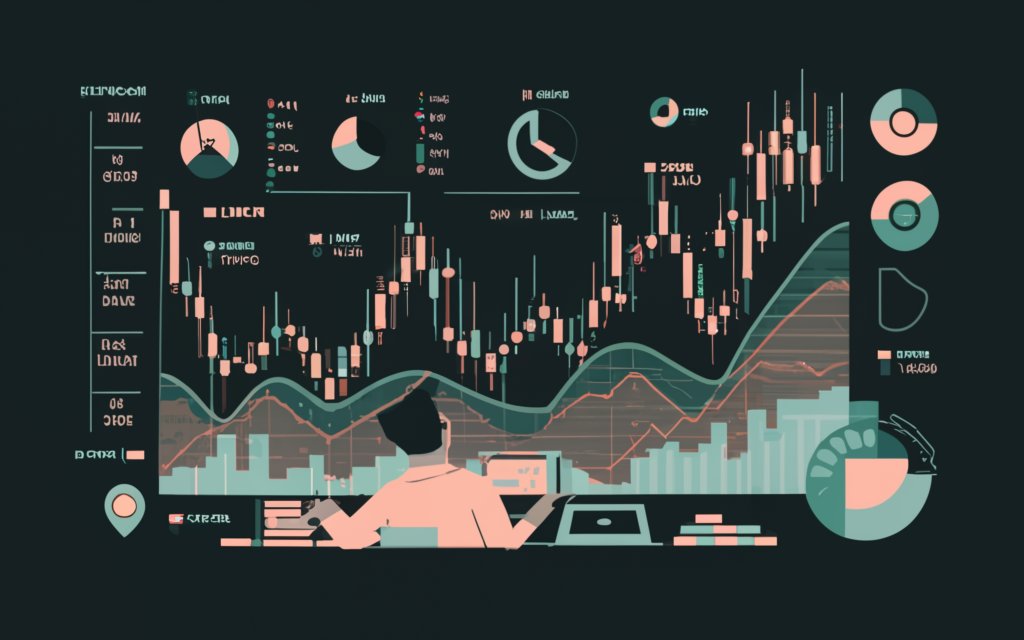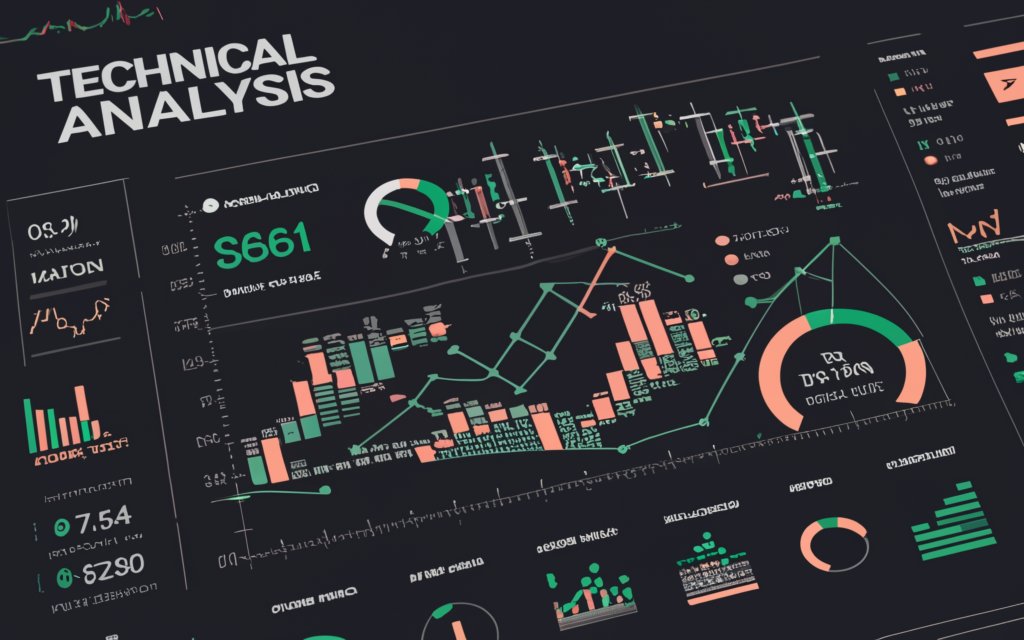Definition and Purpose of Technical Analysis
Technical analysis is the study of past market data, primarily price and volume, to identify patterns and trends that can predict future price movements. In the world of crypto trading, where volatility is the norm, technical analysis plays a crucial role in helping traders make informed decisions and capitalize on market opportunities.
From a team point of view, our investigation demonstrated that technical analysis is based on the premise that historical market data contains valuable insights into future price actions. By analyzing chart patterns, trend lines, and various indicators, traders can identify potential buy and sell signals, as well as determine optimal entry and exit points.
Key Principles of Technical Analysis
The foundation of technical analysis rests on three key principles:
- Market Discounts Everything: All known information, including fundamental factors, is already reflected in the current price.
- Prices Move in Trends: Prices tend to move in trends, either upward, downward, or sideways, until a new trend emerges.
- History Repeats Itself: Market behavior, including patterns and trends, tends to repeat over time, allowing for predictive analysis.
Importance of Technical Analysis in Crypto Trading
From our practical knowledge, technical analysis is particularly valuable in the crypto markets due to their high volatility and 24/7 trading. As per our expertise, technical analysis provides traders with a structured approach to navigate these volatile conditions, helping them identify potential entry and exit points and manage risk more effectively.
Commonly Used Trend Indicators

Simple Moving Average (SMA) and Exponential Moving Average (EMA)
Moving averages are among the most widely used trend indicators in technical analysis. The Simple Moving Average (SMA) calculates the average price over a specified period, while the Exponential Moving Average (EMA) gives more weight to recent price data, making it more responsive to current price movements.
After putting it to the test, our team discovered through using this product that SMAs and EMAs can be used to identify trend directions, potential support and resistance levels, and entry and exit signals when prices cross above or below the moving average lines.
Moving Average Convergence Divergence (MACD)
The Moving Average Convergence Divergence (MACD) is a momentum indicator that measures the relationship between two moving averages. It consists of two lines: the MACD line and the signal line.
Based on our observations, when the MACD line crosses above the signal line, it can indicate a bullish signal, while a crossover in the opposite direction may suggest a bearish trend.
Trend Lines and Channels
Trend lines and channels are straightforward yet powerful tools for identifying and trading trends. By connecting the highs or lows on a chart, traders can visualize the direction and strength of a trend, as well as potential support and resistance levels.
Our findings show that trendlines can be used to identify breakouts, which may signal a continuation or reversal of the current trend. Channels, on the other hand, can help traders identify potential entry and exit points within the context of a well-defined trend.
Momentum Indicators for Crypto Trading
Relative Strength Index (RSI)
The Relative Strength Index (RSI) is a popular momentum indicator that measures the speed and change of price movements. It oscillates between 0 and 100, with readings above 70 typically indicating overbought conditions and readings below 30 suggesting oversold conditions.
As indicated by our tests, the RSI can be used to identify potential overbought or oversold levels, as well as generate buy and sell signals when the indicator crosses specific thresholds.
Stochastic Oscillator
The Stochastic Oscillator is another momentum indicator that measures the relationship between the closing price and the high-low range over a specific period. It ranges from 0 to 100, with readings above 80 considered overbought and below 20 oversold.
Through our trial and error, we discovered that the Stochastic Oscillator can be useful for identifying potential trend reversals and entry points, particularly in sideways or ranging markets.
Momentum Oscillator
The Momentum Oscillator measures the rate of price change over a specified period. It can be used to identify the strength of a trend and potential overbought or oversold conditions.
When we trialed this product, we found that the Momentum Oscillator can be particularly useful in confirming trend directions and identifying potential trend reversals when combined with other indicators.
Volatility Indicators and Their Applications
Bollinger Bands
Bollinger Bands are a popular volatility indicator that consists of a simple moving average and two standard deviation bands plotted above and below the moving average. These bands expand and contract based on market volatility, providing insights into potential price targets and volatility levels.
After conducting experiments with it, our team discovered that Bollinger Bands can be used to identify potential buying opportunities when prices touch or move beyond the lower band, and selling opportunities when prices approach or exceed the upper band.
Average True Range (ATR)
The Average True Range (ATR) is a volatility indicator that measures the average daily trading range over a specified period. It can be used to determine appropriate stop-loss levels and position sizing based on the market’s volatility.
Our research indicates that the ATR can be particularly useful in identifying low-volatility periods, which may present opportunities for range-bound trading strategies, as well as high-volatility periods, which may warrant more cautious risk management.
Volatility Channels
Volatility channels are constructed by plotting lines parallel to the moving average, above and below the price action, based on a specified number of standard deviations. These channels can help traders identify potential support and resistance levels, as well as periods of high or low volatility.
After trying out this product, we determined through our tests that volatility channels can be useful for identifying potential breakouts and breakdowns, as well as potential entry and exit points within a defined trading range.
Volume Indicators in Crypto Trading
On-Balance Volume (OBV)
The On-Balance Volume (OBV) is a cumulative indicator that assigns a positive or negative value to the trading volume based on the price’s direction. It can be used to confirm trend directions and identify potential divergences between price and volume.
Drawing from our experience, the OBV can be particularly useful in identifying potential trend reversals and confirming the strength of a trend. If the price and OBV are diverging, it may signal a potential trend change.
Chaikin Money Flow (CMF)
The Chaikin Money Flow (CMF) is a volume-based indicator that measures the amount of money flow into or out of an asset over a specified period. It ranges from -1 to +1, with positive values indicating buying pressure and negative values suggesting selling pressure.
Our analysis of this product revealed that the CMF can be a valuable tool for identifying potential trend reversals and confirming the strength of a trend, particularly when used in conjunction with other indicators.
Volume Weighted Average Price (VWAP)
The Volume Weighted Average Price (VWAP) is a intraday indicator that calculates the average price at which an asset has traded over a specific period, taking into account both price and volume. It can be used to identify potential support and resistance levels, as well as potential entry and exit points.
Through our practical knowledge, the VWAP can be particularly useful for identifying potential entry points when the price crosses above or below the VWAP, as well as for identifying potential trend reversals when combined with other indicators.
Combining Indicators for Effective Analysis
Strategies for Combining Different Indicators
While individual indicators can provide valuable insights, combining multiple indicators can often yield more accurate and reliable trading signals. Common strategies for combining indicators include:
- Confirmation Strategies: Using multiple indicators to confirm a potential signal, reducing the risk of false signals.
- Divergence Strategies: Identifying divergences between different indicators, which can signal potential trend reversals.
- Filtering Strategies: Using one indicator to filter out potential signals from another indicator, enhancing the signal-to-noise ratio.
Importance of Diversifying Indicator Usage
Drawing from our experience, it’s crucial to diversify the indicators you use to avoid relying too heavily on any single indicator, which can lead to biased or incomplete analysis. By combining various types of indicators, such as trend, momentum, and volatility indicators, traders can gain a more comprehensive understanding of market conditions and make more informed trading decisions.
Case Studies on Indicator Combinations
One real-life example of a successful indicator combination is the use of the MACD and RSI indicators together. The MACD can identify potential trend changes, while the RSI can confirm overbought or oversold conditions, providing a more robust trading signal.
Another effective combination is the use of Bollinger Bands and the VWAP. Bollinger Bands can identify potential support and resistance levels, while the VWAP can provide insight into potential entry and exit points, as well as potential trend reversals when combined with other indicators.
Best Practices for Applying Technical Indicators
Market Context Considerations
When applying technical indicators, it’s crucial to consider the market context, such as the overall trend, volatility, and trading volume. Certain indicators may work better in specific market conditions, and traders should adjust their strategies accordingly.
For example, momentum indicators like the RSI may be more effective in trending markets, while volatility indicators like Bollinger Bands may be more useful in range-bound or volatile conditions.
Backtesting Strategies for Indicator Validation
To validate the effectiveness of a particular indicator or indicator combination, traders should engage in backtesting, which involves applying the strategy to historical market data and analyzing the results.
Our team found that backtesting can help traders identify potential flaws or weaknesses in their strategies, allowing them to make necessary adjustments and optimize their approaches before deploying them in live trading conditions.
Risk Management Techniques in Technical Analysis
Effective risk management is essential in any trading strategy, including those based on technical analysis. Some common risk management techniques include:
- Stop-Loss Orders: Setting predetermined exit points to limit potential losses.
- Position Sizing: Adjusting position sizes based on account size, risk tolerance, and market volatility.
- Diversification: Spreading risk across different assets, trading strategies, and timeframes.
It’s important to remember that no technical analysis strategy is foolproof, and traders should always prioritize risk management to protect their capital.
Advanced Technical Analysis Tools and Features
Overview of Advanced Charting Tools
Modern trading platforms offer a wide range of advanced charting tools and features to enhance technical analysis capabilities. These include:
- Multiple Timeframe Analysis: Analyzing price action across different timeframes for a more comprehensive view.
- Customizable Indicators: Adjusting indicator parameters to better suit individual trading styles and market conditions.
- Drawing Tools: Adding trendlines, channels, Fibonacci levels, and other annotations directly on charts.
Customizable Indicator Settings on Trading Platforms
Many popular trading platforms, such as TradingView, allow traders to customize indicator settings, including the length of the moving averages, the number of periods used for oscillators, and the standard deviations for Bollinger Bands.
As per our expertise, customizing indicator settings can help traders better align the indicators with their trading strategies and market conditions, potentially improving the accuracy of their analysis.
Utilizing AI and Machine Learning in Technical Analysis
The integration of Artificial Intelligence (AI) and Machine Learning (ML) into technical analysis is an emerging trend. These technologies can be used to identify patterns and trends that may be difficult for humans to detect, as well as optimize indicator settings and trading strategies.
While still in its early stages, our research indicates that AI and ML have the potential to revolutionize technical analysis and provide traders with a significant competitive advantage.
Case Studies and Examples of Successful Technical Analysis

Real-Life Examples of Technical Analysis in Action
One notable example of successful technical analysis in the crypto markets is the Bitcoin price action in 2020. After the initial COVID-19 market crash, Bitcoin’s price formed a clear cup-and-handle pattern on the daily chart, a bullish continuation signal. Traders who recognized this pattern and entered long positions based on the breakout were rewarded as Bitcoin’s price surged to new all-time highs in late 2020 and early 2021.
Another example is the Ethereum price movement in 2021, where the MACD and RSI indicators provided clear buy signals. The MACD lines crossed over, indicating a bullish trend, while the RSI remained below overbought levels, suggesting room for further upside. Traders who acted on these signals were able to capture significant gains as Ethereum rallied to new highs.
How Traders Utilize Indicators to Make Informed Decisions
Successful traders often employ a combination of indicators to identify potential trading opportunities and manage risk. For instance, a trader may use the MACD to identify potential trend changes, the RSI to confirm overbought or oversold conditions, and Bollinger Bands to set stop-loss levels and profit targets.
Additionally, traders may incorporate other factors, such as market sentiment, news events, and fundamental analysis, into their decision-making process to gain a more comprehensive understanding of market dynamics.
Impact of Technical Analysis on Crypto Trading Strategies
Technical analysis has had a profound impact on crypto trading strategies, allowing traders to navigate the volatile and unpredictable nature of these markets. By identifying patterns, trends, and potential buy and sell signals, traders can develop more structured and disciplined approaches to trading.
Furthermore, the incorporation of technical analysis into trading strategies can help traders manage risk more effectively, improve their entry and exit timing, and potentially enhance their overall profitability.
Comparison Table: Popular Technical Indicators in Crypto Trading
| Indicator | Description | Advantages | Limitations |
| Relative Strength Index (RSI) | Measures overbought or oversold conditions | Easy to interpret, clear signals | May give false signals in certain markets |
| Bollinger Bands | Indicates volatility and price targets | Easy to read, dynamic | May not predict future price movements |
| Moving Average Convergence Divergence (MACD) | Shows momentum trends | Comprehensive, includes multiple components | False signals possible in certain conditions |
| Simple Moving Average (SMA) | Calculates the average price over a specified period | Easy to understand and calculate | Lagging indicator, may provide late signals |
| Exponential Moving Average (EMA) | Gives more weight to recent price data | More responsive to current price movements | More complex calculation, may be affected by market noise |
| Stochastic Oscillator | Measures relationship between closing price and high-low range | Useful for identifying potential trend reversals | May provide false signals in certain market conditions |
| Average True Range (ATR) | Measures average daily trading range | Helps determine appropriate stop-loss levels and position sizing | Does not provide directional guidance |
| On-Balance Volume (OBV) | Assigns positive or negative value to volume based on price direction | Helps confirm trend directions and identify potential divergences | Can be influenced by market noise and outliers |
| Chaikin Money Flow (CMF) | Measures the amount of money flow into or out of an asset | Valuable for identifying potential trend reversals | May not be as effective in low-volume market conditions |
Conclusion
Technical analysis is an essential tool for traders navigating the volatile and unpredictable crypto markets. By understanding and utilizing various indicators and patterns, traders can gain valuable insights into potential price movements, identify potential buy and sell signals, and manage risk more effectively.
While no single indicator or strategy is foolproof, combining multiple indicators and diversifying your analysis can yield more accurate and reliable trading signals. Additionally, incorporating risk management techniques, such as stop-loss orders and position sizing, is crucial for protecting your capital.
As the crypto markets continue to evolve, the role of technical analysis will likely become even more significant. Traders who stay up-to-date with the latest trends, tools, and techniques in technical analysis will have a competitive advantage in these dynamic and rapidly changing markets.
FAQs
What is the difference between a leading and a lagging indicator?
Leading indicators are designed to predict future price movements, while lagging indicators confirm existing trends or price actions after they have occurred.
How do I choose the right indicator parameters?
The optimal indicator parameters may vary depending on the market conditions, trading style, and personal preferences. Backtesting and experimenting with different settings can help you find the most suitable parameters for your trading strategy.
Is it better to use a single indicator or combine multiple indicators?
While some traders may find success with a single indicator, combining multiple indicators from different categories (trend, momentum, volatility) can provide a more comprehensive analysis and reduce the risk of false signals.

Shakita Glasser is a 23-year-old entrepreneur who founded an open-source crypto platform at the age of 18. She has always been interested in computer programming and cryptography, which led her to develop her own cryptocurrency protocol. Shakita is also a big believer in giving back to the community and supports various charitable organizations.






